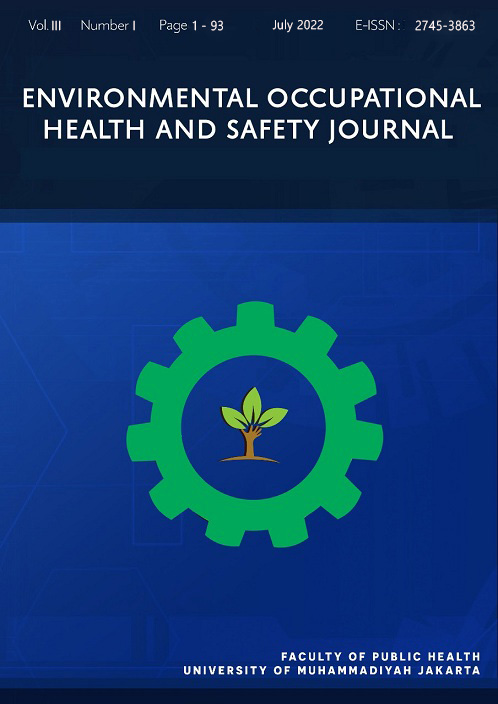Pengetahuan Dan Perilaku Makanan Jajanan Terhadap Kejadian Diare Pada Siswa Sd Negeri Setu Kota Tangerang Selatan
Main Article Content
Abstract
Article Details
References
Nemeth V, Pfleghaar N. Diarrhea. Treasure Island (FL): StatPearls Publishing; 2021.
Drancourt M. Acute Diarrhea. In: Infectious Diseases, 2-Volume Set. Elsevier; 2017. p. 335-340.e2.
Unicef. Pneumonia and diarrhoea: Tackling the deadliest diseases for the world’s poorest children. United Nations Children’s Fund. 2012. 1–86 p.
Viegelmann GC, Dorji J, Guo X, Lim HY. Approach to diarrhoeal disorders in children. Singapore Med J. 2021;62(12):623–9.
World Health Organization (WHO). Diarrhoeal disease [Internet]. WHO Fact Sheets. 2017. Available from: https://www.who.int/news-room/fact-sheets/detail/diarrhoeal-disease
Wolde D, Tilahun GA, Kotiso KS, Medhin G, Eguale T. The Burden of Diarrheal Diseases and Its Associated Factors among Under-Five Children in Welkite Town: A Community Based Cross-Sectional Study. Int J Public Health. 2022;67(October):1–9.
Badan Penelitian dan Pengembangan Kesehatan. Riset Kesehatan Dasar (RISKESDAS) 2013. Laporan Nasional 2013. 2013.
World Health Organization (WHO). WHO methods and data sources for global burden of disease estimates 2000-2019. Global Health Estimates Technical Paper WHO/ DDI/DNA/GHE/2020.3 WHO/DDI/DNA. 2020.
Badan Penelitian dan Pengembangan Kesehatan. Riset kesehatan dasar (Riskesdas) 2018. Jakarta: Departemen Kesehatan RI; 2018.
Dinas Kesehatan Provinsi Banten. Profil Kesehatan Provinsi Banten Tahun 2016. 2017.
Rumah Sakit Umum Kota Tangerang Selatan. Laporan Kinerja Instansi Pemerintah Rumah Sakit Umum Kota Tangerang Selatan Tahun 2018. 2019.
Bellido-Blasco J, Arnedo-Pena A. Epidemiology of Infectious Diarrhea. Encycl Environ Heal. 2011;569–81.
Wijayanti SPM, Sidik M, Iqbal A. The Determinants of Diarrhea Disease Incidence in Densely Populated Area of West Nusa Tenggara, Indonesia. J Kesehat Lingkung. 2020;12(2):107.
Erismann S, Knoblauch AM, Diagbouga S, Odermatt P, Gerold J, Shrestha A, et al. Prevalence and risk factors of undernutrition among schoolchildren in the Plateau Central and Centre-Ouest regions of Burkina Faso. Infect Dis Poverty. 2017;6(1):1–14.
Bloomfield SF, Aiello AE, Cookson B, O’Boyle C, Larson EL. The effectiveness of hand hygiene procedures in reducing the risks of infections in home and community settings including handwashing and alcohol-based hand sanitizers. Am J Infect Control. 2007;35(10 SUPPL. 1).
Sepadi MM, Nkosi V. Environmental and Occupational Health Exposures and Outcomes of Informal Street Food Vendors in South Africa: A Quasi-Systematic Review. Int J Environ Res Public Health. 2022;19(3).
Dey S, Nagababu BH. Applications of food color and bio-preservatives in the food and its effect on the human health. Food Chem Adv. 2022;1(September 2021):1–13.
Khaliq A, Amreen, Jameel N, Krauth SJ. Knowledge and Practices on the Prevention and Management of Diarrhea in Children Under-2 Years Among Women Dwelling in Urban Slums of Karachi, Pakistan. Matern Child Health J. 2022;26(7):1442–52.
Bintsis T. Foodborne pathogens. AIMS Microbiol. 2017;3(3):529–63.
Brockett S, Wolfe MK, Hamot A, Appiah GD, Mintz ED, Lantagne D. Associations among water, sanitation, and hygiene, and food exposures and typhoid fever in case–control studies: A systematic review and meta-analysis. Am J Trop Med Hyg. 2020;103(3):1020–31.
Okullo JO, Moturi WN, Ogendi GM. Open Defaecation and Its Effects on the Bacteriological Quality of Drinking Water Sources in Isiolo County, Kenya. Environ Health Insights. 2017;11:1–8.
